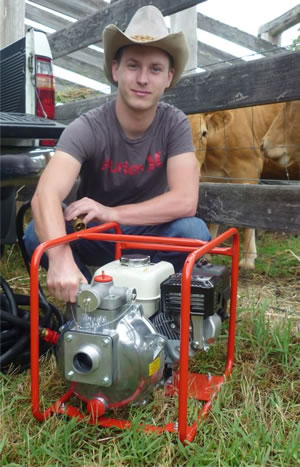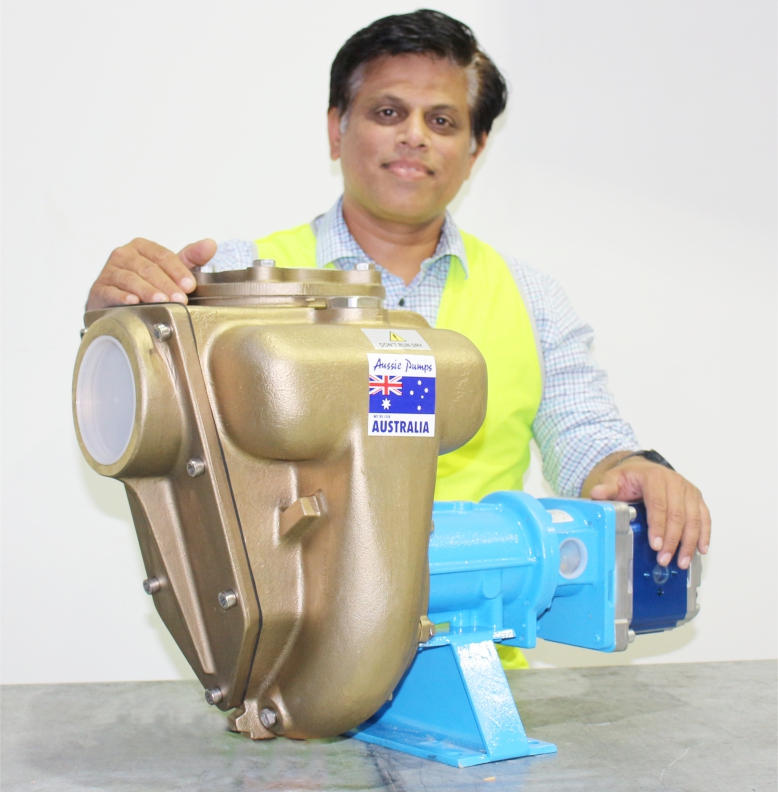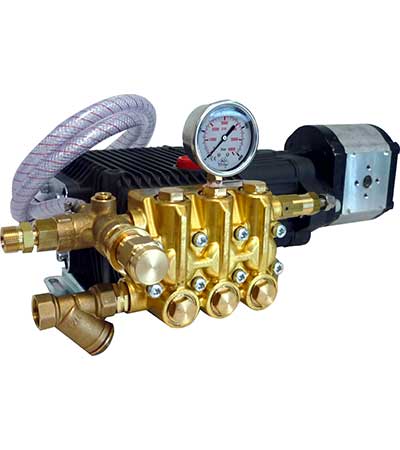
Model: Aussie Fire Chief
As the temperatures start to warm the risk from grass fires significantly increases. A combination of a series of dry, hot days, combined with high speed winds, can turn verdant paddocks into a fire holocaust in a matter of minutes. Grass fires have been known to spread at up to 30km/h, trapping livestock and taking farmers by complete surprise.
“Too often, valuable cattle and sheep, sometimes even top quality stud animals, are lost through lack of planning,” said Aussie Pumps product manager, Brad Farrugia.
Australian Pump Industries stress the need for graziers and major livestock producers to have a “fire safe” plan in place. The company is regarded as a world leader in the design of portable high pressure fire pumps. After consultation with Government departments and fire fighting authorities, they developed a simple plan for livestock protection.
1. Identify safe havens
The area needs to be centrally located, easy to access and strategically placed, not adjoining timbered or brush area. There are a few factors that are important when planning your area.
Grass type: A paddock containing green summer crops will offer good protection, as it will not burn as readily as a paddock that has dry long grass. The DPI (NSW Department of Primary Industries) suggest a paddock that has been systematically grazed in spring and early summer to reduce dry feed will also suit for a low risk area.
Sufficient drinking water: Animals are susceptible to radiant heat, stress and dehydration. Ensure there is sufficient drinking water, i.e. a dam or stream to enable stock to remain in the area during periods of high to extreme temperatures.
Adequate amount of feed: Livestock may need to stay for a extended period of time. A supply of feed is very important to avoid sickness and maintain health levels.
Fire break: A low risk area needs at least a 20m wide cleared or ploughed perimeter. Ensure that the area is clear of any unnecessary combustible material (leaves, bark, branches, etc).
2. Speed is of the essence
Under some circumstances it may even be necessary to move stock early on high fire danger days. Be prepared, think out the plan in advance.
3. Sufficient fire fighting equipment
Be prepared to put out spot fires and wet down danger areas. A trailer or ute mounted fire pump and tank will provide a mobile option. Make sure the pump is capable of delivering sufficient water.
“We developed the Aussie Fire Chief for applications just like this,” said Farrugia. “We have a hugely efficient pump design that develops pressures of up to 100psi and flows of up to 450 litres/per minute. The Fire Chief has proved itself to be the design and reliability leader time and again,” he said.
The Fire Chief is considered the world’s finest lightweight portable fire pump. Apart from being used by major Government departments and fire fighting authorities around Australia, the product has been widely accepted in Europe, Africa and in some areas of South East Asia. “We even supplied this superbly engineered product to US customers, who are amazed to find that there is no similar product made in the USA!” said Farrugia.
The Fire Chief is powered by a genuine Honda petrol engine and comes standard with heavy duty steel skids and anti-vibration mounts. An optional one piece welded steel roll frame is also available.
The Chief’s big brother, the Aussie Mr T is a mighty twin impeller pump that develops pressures of up to 130psi and flows to 550 litres/minute. It comes with either Honda 9hp or 13hp petrol engine, available in recoil or electric start. A big Yanmar 10hp diesel drive with electric start is a popular choice as well. Diesel fuel is considered much safer than petrol because of its lower flash point.
“Many farmers are changing over to the big Yanmar diesels because of the inherent fire safety, lower running costs and overall reliability,” said Farrugia.
All the Australian Pump fire pump range offer a self-priming feature that ensure the pump primes, first time, every time. Only Aussie offers a vertical suction lift of up to 7.6 metres, enabling the operator to draw water from wells, streams or dams.
“That’s a major feature and can be a matter of life or death, when a fire is on the move”, said Farrugia. “We’ve heard horror stories about third world pumps, sometimes masquerading under popularly advertised brands, that simply won’t prime in an emergency!” he said.
Australian Pump is unique in offering a 5 year warranty on all of their Aussie Quik Prime product range.
Further information including guidelines on how to protect property, life and livestock is readily available from Australian Pump Industries, along with a copy of the company’s current complete product guide. Further information is also available from our Aussie Quik Prime Petrol Drive Fire Pumps PDF, Aussie Quik Prime Diesel Drive Fire Pumps PDF or from Aussie Gold Distributors across Australia.




